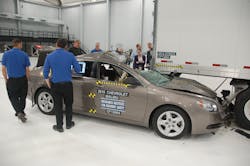NTSB wants side underride guards
THE National Transportation Safety Board has recommended that side underride guards be required on trailers with GVW ratings above 10,000 pounds.
In a letter to dated April 3, the National Transportation Safety Board (NTSB) urged the National Highway Traffic Safety Administration to require guards that would protect passenger cars from running under trailers. The NTSB also is asking NHTSA to require side underride protection on highway tractors rated above 26,000 pounds GVW.
The NTSB cites General Estimates System (GES) reports that say 43,629 police-reported collisions occurred between 2005 and 2009 in which passenger vehicles collided with the sides of trailers. The NTSB also cited a NHTSA reported that said large truck side impacts comprised 15% of fatal two-vehicle collisions between large trucks and passenger vehicles during 2011. Other research indicated that passenger vehicle collisions with the sides of tractor-trailers resulted in more than 15,000 injured persons during 2001-2003, the NTSB said.
The board also wants changes to existing rear underride regulations. The NTSB concluded that passenger vehicle occupant injuries caused by rear underride accidents could be reduced by making changes to guard design. The NTSB recommends that NHTSA revise requirements for rear underride protection systems for newly manufactured trailers with GVWRs over 10,000 pounds. The recommendation is based in part on recent crash testing that included offset crashes.
Additionally, NTSB recommends that NHTSA add trailer VIN and trailer model year to the Fatality Analysis Reporting System database for trailers with GVWRs over 10,000 pounds.
“Although the majority of collisions involving the sides or rears of tractor-trailers consist of impacts to the trailers, police reports provide less information for trailers than for other types of motor vehicles,” Deborah A P Hersman, NTSB chairman, wrote in her letter to NHTSA. “This is reflected in police accident report forms: few include spaces for the vehicle identification number (VIN) or license plate numbers of trailers. Also, the forms do not instruct police officers to fill in this information for trailers.”
When included in the accident report, the VIN can be decoded to indicate the trailer manufacturer, model year, and other trailer characteristics.
NTSB believes that better data is needed so that injuries and fatalities incurred in traffic accidents with trailers can be tracked more effectively by state and national traffic accident databases. The NTSB concludes that trailer VINs and trailer model year information are necessary to detect risks associated with trailer designs and to evaluate the effectiveness of safety regulations for trailers.
